Recent Posts
Get Mildew Smell Out of Carpet in 6 Steps
2/2/2024 (Permalink)
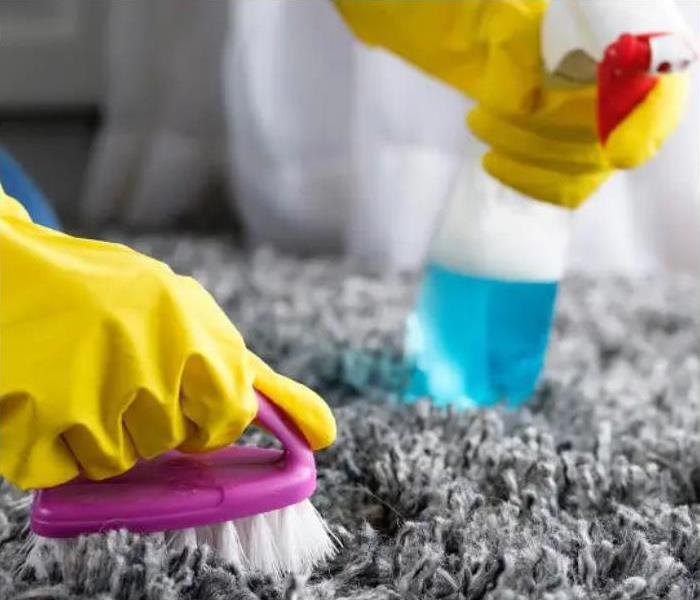 Whether it's due to spills, leaks, humidity, or lack of ventilation, it’s important to get that mildew smell out of the carpet as soon as possible.
Whether it's due to spills, leaks, humidity, or lack of ventilation, it’s important to get that mildew smell out of the carpet as soon as possible.
Step 1: Identify and Eliminate the Source
Locating the source of the odor is the first step in eradicating the mildew smell. Make sure the carpet is not damp. Check the walls and ceilings for signs of water damage or leaks. Don't forget to check under furniture.
Once the source is identified, fix any leaks or spills and thoroughly dry the area. It may be necessary to pull back the edges of the carpet or remove baseboards to allow air to circulate. Consider using a dehumidifier to eliminate moisture from the air and carpet.
Replace any water-damaged carpet padding to prevent the smell from coming back. If sections of the carpet itself are damaged, it may be necessary to cut them out and replace them.
Step 2: Vacuum the Carpet
Vacuum slowly and thoroughly, going over the entire carpeted area in overlapping passes. The vacuum may have special tools like a crevice attachment that can also come in handy for hard-to-reach areas where mildew lurks.
Empty the vacuum and wipe the filters after each use to prevent transferring mildew spores back to the carpet. You may need to vacuum a few times to get it all.
Just vacuuming won't remove the smell, but it helps by reducing mildew in carpet, making the rest of the process more efficient.
Step 3: Apply a Cleaning Solution
With the debris gone, the next step is to sanitize the carpet by applying a cleaning solution. Depending on your preference, you can use commercial carpet cleaning products or tried-and-true home remedies. If you prefer home remedies, here are some effective ones to try:
- Baking Soda/Salt: Generously sprinkle on the carpet and let it sit overnight, then vacuum.
- Alcohol: If the carpet isn’t too damp, high-proof cleaning alcohol is effective for addressing small to medium areas.
- Hydrogen Peroxide: Essentially a bleach, it must be diluted 20:1 with water and used on a completely dry carpet.
- Vinegar: An acidic, inexpensive, nontoxic solution. However, it has a strong odor and may cause skin irritation, so it should be handled with personal protective gear.
Step 4: Scrub the Carpet
For small areas, use an old scrub brush, toothbrush, or scrub pad. For larger areas, rent an electric carpet scrubber or steam cleaner. Apply the solution and scrub in small circles, working from the outside in. Let the solution sit for at least 30 minutes unless the label's instructions say otherwise.
After applying the cleaning product, use a towel or a wet/dry vac to absorb as much moisture as possible. Rinse thoroughly with water to remove any remaining residue. You may need to repeat this step a few times for tough stains. Be careful not to oversaturate the carpet with liquid.
Once you’re done scrubbing, open windows to ventilate and speed up the drying time. Running an air purifier with a HEPA filter can also help eliminate any remaining musty smells in the room.
Step 5: Let It Dry
Now that as much of the water as possible is soaked up, it’s time to let the carpet air dry completely.
Leave the windows open and use fans to speed up drying time. The faster the carpet dries, the less chance the mildew smell has to settle in and spread. Continue to circulate the air around the damp area with fans. Turn on any overhead or portable fans to keep the air moving.
Aiming a fan directly at the damp area of the carpet will speed up evaporation. For small, isolated areas, it may take 8 to 12 hours to dry the area completely. Wall-to-wall carpet or carpet in rooms with little air circulation may take 24 hours or longer to dry completely.
Leaving the carpet damp for too long allows mildew to grow rapidly. Prioritize drying the carpet quickly to avoid a full-on mildew infestation. Speedy drying, combined with the suggested cleaning steps, should leave the carpet mildew-free and smelling fresh again.
Step 6: Deodorize
Baking soda is a natural odor absorber that can help freshen the carpet. Sprinkle baking soda liberally over the entire carpeted area. Let it sit for at least a few hours or overnight. The baking soda should absorb the mildew and musty smells from the carpet.
Vacuum the baking soda thoroughly using the hose or brush attachment on the vacuum. You may need to go over the area a few times to pick up all the baking soda granules.
For tough smells, try using activated charcoal, which is very porous and effective at absorbing odors. Place containers of activated charcoal around the room. Replace or refresh the charcoal every month or so.
Commercial carpet deodorizers and powders can also help eliminate odors. Look for natural, fragrance-free products, and always follow the directions carefully. Reapply as needed until the musty smell has disappeared.
Be Aware of How Fires Start
10/9/2023 (Permalink)
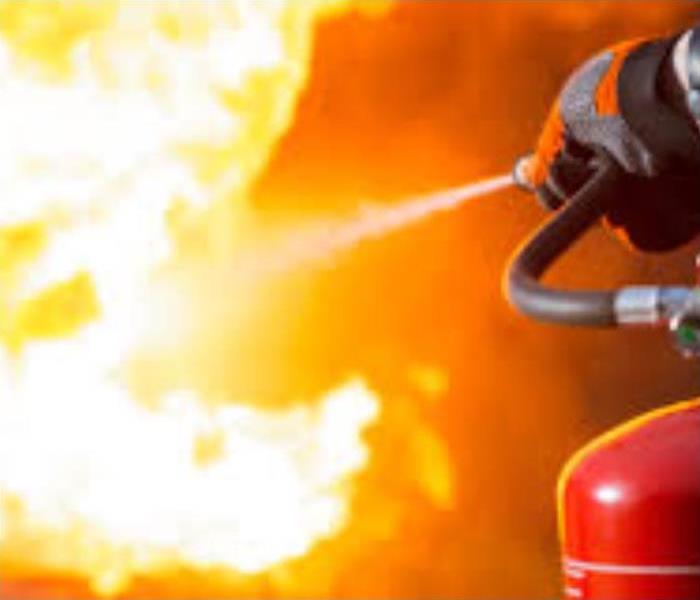 Recognizing fire hazards, can help ensure you stop blazes before they start.
Recognizing fire hazards, can help ensure you stop blazes before they start.
You know building fires can be destructive, but are you familiar with the most common fire starters in homes and businesses? By recognizing these fire hazards, you can take steps to ensure you stop blazes before they start.
Unattended Kitchen Appliances
The kitchen is the most fire-prone room in your home. If you own a restaurant or other business with cooking equipment, it’s vital to never leave appliances unattended. Likely hazards include grease becoming overheated, bread toasting too long, or a cookbook getting too close to an open flame, and they are all enough to start a fire.
Unsafe Cooking Methods
Keep the cooking area clean and roll up your sleeves so they can’t catch fire over a hot stove. Only place microwave-safe dishes in the microwave. Remain alert when cooking and keep kids and pets out of the kitchen. Never cook while under the influence of alcohol.
Worn Out Electrical Cords
Frayed or damaged cords are common fire starters in both homes and businesses. Exposed wires heat up and could ignite surrounding textiles, including the carpet or an area rug. Keep an eye on the condition of your electrical cords and keep your pets from chewing them so they remain in good condition.
Overloaded Power Strips
This situation is particularly common during the holidays when homeowners overpower a single outlet with too many Christmas lights. Use only heavy duty extension cords and avoid overloading the circuit, which can cause a spark and create a serious fire hazard.
Malfunctioning Electrical Appliances
Most homes and businesses rely on electrical appliances for daily tasks. Any of these are prone to malfunction at one point or another, especially toward the end of the equipment’s lifespan. Malfunctions sometimes result in a spark, which is obviously a substantial fire hazard. Faulty coffee makers, toasters, TVs, laptops and other electronics have been to blame for serious fires.
Flammable Products Placed Near Sources of Ignition
There are countless examples of flammable products igniting when they come in contact with sources of heat. A lamp shade touching a hot light bulb, curtains situated too close to an electric space heater, and an aerosol spray can used near the stove are just a few examples.
Unattended Candles
Candles lead to hundreds of house fires every year. Make sure you never place a burning candle near curtains, lampshades or anything else flammable. Place candles in adequate holders and place them on a steady surface away from the edge. Even with these precautions, never leave burning candles unattended. All it takes is a moment for a child or pet to nudge the candle or knock it over.
Fireplace or Wood Stove
When used improperly, fireplaces and wood stoves are common fire starters. Make sure the chimney is unobstructed before burning anything. Wait to dispose of ashes until they are completely cool to the touch. Even the tiniest smoldering embers could start a fire in the trash can.
Unsafe Smoking Practices
Cigarettes are a substantial fire hazard. Habits such as smoking in bed, leaving lit cigarettes unattended, or emptying the contents of an ashtray before they cool are the cause of hundreds of fires every year. Your best bet is to smoke outside and dispose of cigarettes in noncombustible containers, not in flower pots or as litter on the street.
Matches and Lighters
If these get into the hands of children, they can become lethal, fire-starting weapons. If you smoke, keep only one lighter or book of matches accessible at a time, and keep them with you. Teach your children to take matches and lighters seriously and to tell an adult if they find any lying around.
If your home or business has experienced the devastating results of fire starters, professional restoration services from SERVPRO of Kendall County can help you get back on your feet.
What to Do If a Tree Falls on Your House
10/6/2023 (Permalink)
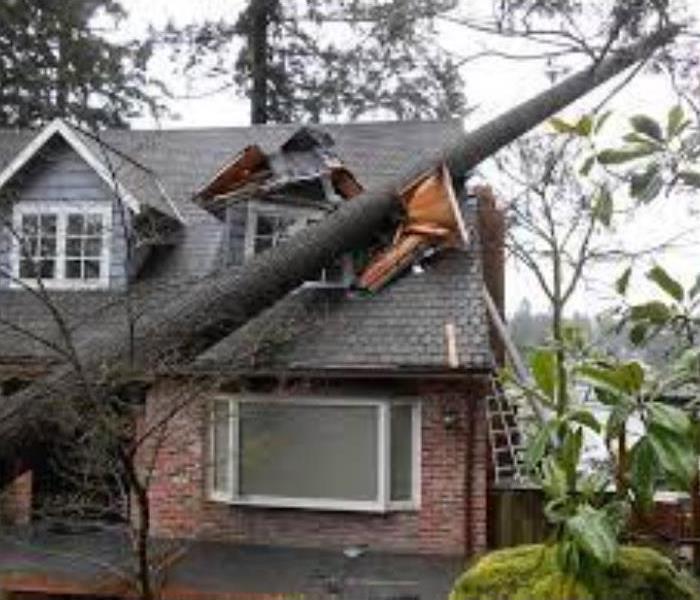 If you’re a homeowner with large trees on or near your property, it’s important to know what to do if one hits your house.
If you’re a homeowner with large trees on or near your property, it’s important to know what to do if one hits your house.
Older neighborhoods can be a joy to live in. Beautiful architecture, friendly neighbors, good schools, and big trees. Unfortunately, sometimes those big trees can be a disadvantage too. Especially if one falls and blocks access to the street, takes down electrical wires or, even worse, lands on your house. So, if you’re a homeowner with large trees on or near your property, it’s important to know what to do if one hits your house.
Why Do Trees Fall?
The two most common reason trees fall are root damage and weather. Trees whose roots have been weakened by root rot, or damaged by construction or ground compaction, can become unstable—especially in the summer months when the canopy is heavy with leaves and the soil may loosen as a result of heavy rain. In some cases, the tree may have shallow roots due to compacted soil or because it’s normal for that tree species. But even a tree with healthy roots can fall because of a combination of saturated ground and high winds or lightning. The worst-case scenario is a hurricane or tornado, but trees can also fall after several days of rain combined with straight-line winds. Keeping your trees’ roots healthy can prevent most disasters, but not all. So, what should you do if the worst happens?
Evacuate the House
If a tree or one of its large limbs crashes through the roof, first make sure all the occupants are safe. Check in with everyone—including your pets—then get out of the house as quickly and safely as possible. Make sure you have a “go bag” prepared or you take items you’ll need like cash, car keys, important documents and, if possible, a change of clothes. Once you know everyone is safe, call 911 so the fire department can help you secure your premises. Although it may be tempting, make sure you:
Don’t climb onto your roof.
Don’t climb onto the fallen tree.
Don’t touch downed power lines.
Signs of Bathroom Water Damage
10/6/2023 (Permalink)
 Water damage is not always easy to find, especially in the bathroom.
Water damage is not always easy to find, especially in the bathroom.
Water damage is not always easy to find, especially in the bathroom. After all, water is a normal occurrence in bathrooms! A broken pipe or fixture is a clear sign of an issue; however, what about the hidden culprits like a cracked shower tile, unstable or old caulking and grout, or a leaky seal on base of the toilet bowl where tiny leaks are causing large amounts of damage to floor boards, ceilings, and walls as well as a potential drain on your wallet of thousands of dollars in repairs?
Knowing what to look for in the game of hide-and-seek “water damage style” is vital for property owners who want to prevent extensive water damage in your bathroom. Consider some of these hints for possible areas of water damage in your bathroom and take action quickly if you find them:
A Soft Floor
If you know your home was built with a wooden floor truss system, the sub floor is most likely made of plywood. If the plywood is subjected to moisture, the subfloor will rot and the floor will begin to feel soft or spongy in places. Your toilet may also feel unstable when you sit down. This could lead to your entire floor collapsing if left unattended.
Trust Your Nose
If you still smell something musty or damp after a thorough cleaning, it is probably due to moisture damage lurking behind the walls. Although many older homes have this smell, rooms with actual damage have a more prominent smell. Sometimes you might not be able to see it but be sure to trust your nose and call in our professionals to find the affected area.
Warped Walls
This is another clear sign that may point to an extensive problem. When drywall absorbs water, it begins to swell and becomes soft. Over time, the damaged area starts to crumble, especially around the baseboards. If you run your hand across the wall and it feels uneven or looks crooked when you look at it, have it checked by SERVPRO of Kendall County.
How To Prevent Electrical Fires
10/6/2023 (Permalink)
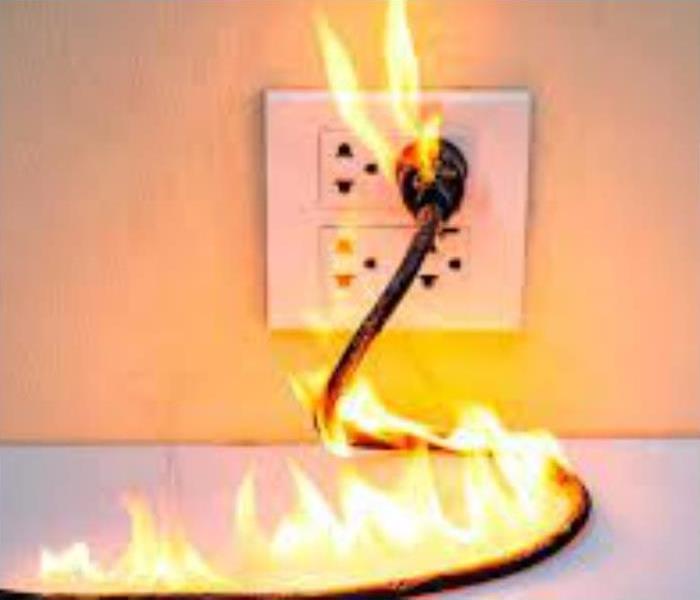 The electrical demands placed on homes puts them at greater risk for electrical-related fires.
The electrical demands placed on homes puts them at greater risk for electrical-related fires.
Across every age group and in every area of the country, people will tell you “I’m so busy,” “I feel so much pressure,” or “I’m so overloaded.” From school-aged children facing classroom and extra-curricular demands and middle-aged adults working long hours to provide the best lifestyle for their families, to the older generation planning retirement or dealing with health-related issues, everyone is facing some type of demand.
But have you ever stopped to think about how overloaded your home may be? Homes today face an overwhelming amount of demands… of the electrical kind! From the central heat and air and appliance to the light fixtures, computers, televisions, and electronic devices most people have nowadays, homes are definitely carrying a tremendous load. The electrical demands placed on homes puts them at greater risk for electrical-related fires.
- Have your home inspected for loose wires, shorts, and faulty wiring that increase the risk for potential electrical fires. Electrical wiring doesn’t last forever. This is especially true if you live in an older home. While older homes offer the grandeur or nostalgic feel some people are looking for, it’s important to check the walls for more than just the stories they may tell. Faulty wiring symptoms can include buzzing outlets, flickering lamps, or plugs that spark when you plug something in. Hire a certified electrician to give your home an inspection to ensure the wiring is safe or may be in need of rewiring.
- Install a smoke detector on every level of your home and inside each bedroom. Also, make sure the smoke detectors are working properly by testing them every month. Make sure that everyone in your home knows the sound of the smoke detector and knows what to do when it goes off. Have a fire escape plan in place and practice it with the whole household.
- Use safe cord practices in the home. Repair or replace loose, frayed, or cracked cords. Never place cords in high traffic areas, under carpets or rugs, or nail or staple cords to surfaces. Consider having additional outlets installed by an electrician; avoid using extension cords long-term.
- Place the correct wattage light bulbs in all fixtures. If the wattage is higher than the requirement, replace them immediately. Secure light bulbs in the socket to ensure they don’t overheat.
No matter how busy you may be, taking a few minutes to look at your home’s risk for electrical fire is time well invested. Prevention is the key for protecting your family and home from the dangers and disaster of electrical fire and the need for SERVPRO of Kendall County in the future .
Preparing Your Home for Severe Weather
10/4/2022 (Permalink)
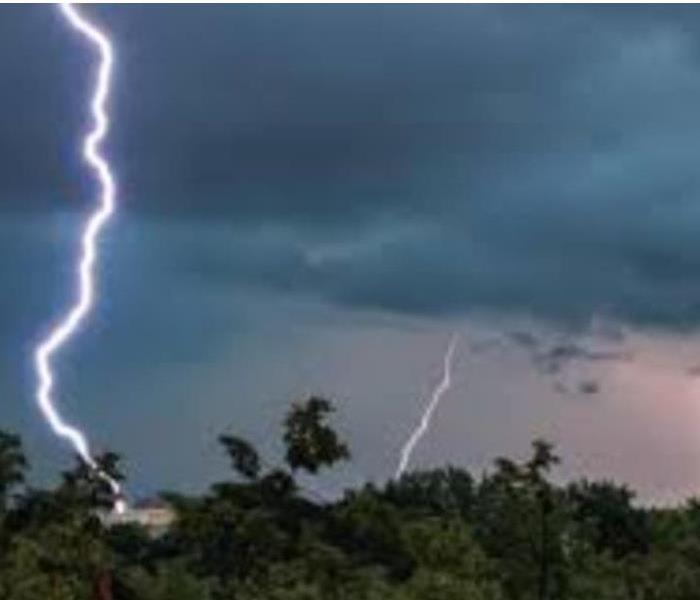 Follow these safety measures and general tips to help you weather the storm.
Follow these safety measures and general tips to help you weather the storm.
Preparing for a Tornado
Every state has at least minimal risk for tornadoes, though the region spanning from South Dakota to Texas is nicknamed Tornado Alley for a reason. Tornado season spans the spring and summer seasons.
Before a tornado hits, follow these severe weather tips:
- Look outside for approaching storms and remain on alert for signs of a tornado, such as a dark sky, large hail, low-lying or fast-moving clouds, or roaring sounds.
- Listen to your NOAA Weather Radio, commercial radio or TV newscasts to remain informed. Follow the instructions given by local emergency officials.
- Recognize emergency alerts during a storm. A tornado watch means a tornado is possible. A tornado warning means a funnel has been spotted.
- If a tornado warning is issued, take shelter in the basement or storm cellar immediately. If your home doesn’t have an underground room, an interior bathroom is the best place to hunker down.
Preparing for a Hurricane
The Atlantic and Gulf of Mexico coastal regions are at risk for hurricanes. The Southwestern US can also experience heavy rains and floods from hurricanes generated off the coast of Mexico. Hurricane season lasts from June to November.
Before a hurricane hits, follow these severe weather tips:
- Learn the elevation of your property to understand your personal flood risk. Determine whether levees and dams in your area could affect you if they break.
- Become familiar with areas of higher ground in your city and determine how you would get there during an emergency.
- Make plans to secure your home, including covering windows with storm shutters or plywood; installing straps to fasten your roof to the frame structure; and reinforcing garage doors.
- Make plans to prepare your property, such as bringing un-tethered outdoor objects inside; trimming back trees and shrubs for better wind resistance; and determining how to secure your boat.
- Recognize emergency alerts during a storm. A hurricane warning means unrelenting winds of 74 miles per hour or higher are expected to create hurricane conditions within the next 36 hours. A hurricane watch is similar, but the alert is issued within 48 hours of the anticipated storm.
Preparing for a Thunderstorm
Thunderstorms are dangerous because they always produce lightning and may produce hail, strong winds, flash flooding, tornadoes and wildfires if lightning strikes the ground. Thunderstorms can occur anywhere in the US and are most likely during the summer.
Before a thunderstorm hits, follow these severe weather tips:
- Prepare your home by shuttering windows and doors, and unplugging sensitive electronics.
- Prepare your property by removing damaged tree branches that could fall during a storm, and bringing outdoor objects inside.
- Watch the sky and tune in to your NOAA Weather Radio for information.
- Recognize emergency alerts during a storm. A severe thunderstorm watch means stormy conditions are likely to occur. A severe thunderstorm warning means radar indicates severe conditions exist.
- If a severe thunderstorm warning is issued, danger is imminent. Seek shelter inside or within a hard-topped vehicle if no buildings are nearby.
General Tips
- Build an emergency kit: You need food, water and basic disaster supplies to last 72 hours. Assemble your emergency kit well before severe weather strikes. You may have to evacuate at a moment’s notice, so keep your emergency kit in an easy-to-access place.
- Create a family communication plan: Your family may be scattered around town at school, work and daycare when a storm hits. That’s why you should create a family communication plan now. Establish how you’ll get in touch, reunite and handle different situations. Make sure every family member has their parents’ and siblings’ cell phone numbers memorized.
- Learn your city’s evacuation plan: If you live in a storm-prone area, your community may have established evacuation routes to leave the area safely and quickly. Learn about these plans and share them with your family.
Why Do I Need SERVPRO of Kendall County to Handle Fire Restoration?
9/27/2022 (Permalink)
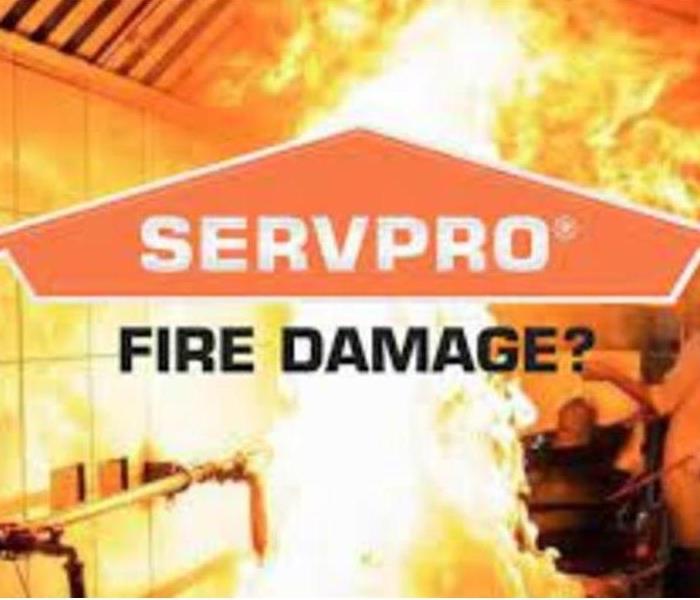 Fire and smoke damage restoration is not a job for amateurs.
Fire and smoke damage restoration is not a job for amateurs.
You Might be Exposed to Hidden Health Hazards
Unfortunately, the dangers of a fire don’t end once the flames go out. The smoke and soot left behind are more than just dirty little reminders of the disaster that took place. Exposure to fire-damaged objects and lingering residue could be hazardous to your health.
Soot forms after a fire because plastic, foam, textiles, wood, and other household materials don’t burn cleanly. The soot then contains toxic materials that either didn’t burn completely or were produced as a chemical reaction in the fire’s high heat.
Invisible soot particles floating through the air may contain cancer-causing asbestos fibers, ammonia, tar, formaldehyde, and much more. Walking through your fire-ravaged home could allow chemically-laden soot to get into your eyes and penetrate your skin.
Exposure to soot in a fire-damaged home is obviously at its highest during the cleanup process. However, unless thorough, adequate cleaning is performed, the health effects of smoke could linger for years. This is why you should leave fire restoration to SERVPRO of Kendall County who can employ deep-cleaning techniques to truly restore your home to its pre-fire condition.
You Need Special Equipment
A bottle of degreaser and a dust mask are not nearly enough to adequately clean up fire and smoke damage. After all, you can’t simply wipe soot away. You must deep clean all surfaces to eliminate lingering health threats and remove residual odors. Professional tools – not to mention knowledge of proper cleaning techniques – are at the heart of a thorough, safe fire restoration.
Also, be aware that laundering smoke-damaged clothing in your washer could deepen the damage and leave undesired odors in the washing machine. You must pursue special dry-cleaning techniques if you hope to salvage clothing damaged in a fire.
You Could Mistakenly Throw Away Salvageable Goods
It’s easy for the untrained eye to sift through damaged belongings and deem many of them a lost cause. However, with advanced recovery techniques, SERVPRO of Kendall County can help minimize your loss. Then, for contaminated items that truly are unrecoverable, proper disposal prevents unnecessary health hazards.
The Recovery Process Could Take Much Longer
Restoring your home back to its pre-fire condition is not a straightforward task. You have belongings to salvage, cleanup to do, and the home’s structure to repair. Then, there are the insurance claims to minimize the fire’s financial impact. The entire process is a headache to attempt yourself.
In fact, your efforts to save money with DIY fire restoration could easily backfire if you throw out salvageable belongings and don’t complete insurance claims correctly. The time it takes to perform the cleanup without help could also be detrimental. Relying on SERVPRO of Kendall County who’s familiar with every aspect of the disaster recovery process is a much better option.
Does Your Business Have A Flood Plan?
9/20/2022 (Permalink)
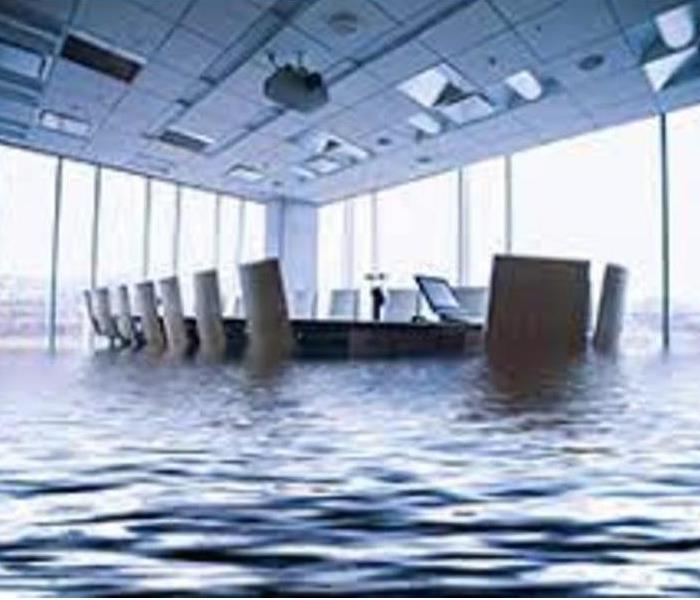 Despite the prevalence of floods, most businesses remain unprepared.
Despite the prevalence of floods, most businesses remain unprepared.
Business Have Unique Flood Preparedness Needs
A flood emergency preparedness plan will be quite different for a construction zone than an office building or industrial facility. Each site and industry suffers unique risks. Industry-specific resources are essential to planning success, as is staff training. A well-informed staff can prevent confusion and added risks to employees and property in the event of disaster.
The Most Basic Flood Evacuation Plan Should Include:
- The capacity for quick response.
With personnel in-charge of monitoring man-made possibilities, and an NOAA Weather Radio or other news resource for natural events. - A basic disaster supply kit.
This includes emergency and medical supplies, as well as enough food and water to last at least 72 hours. Preparedness training at work should likewise instruct employees on preparing their own mobile kit, for preparation to shelter-in-place for 24 hours in the event of emergency. - Plan development and training.
All employees should know what to do in an emergency, including disaster-specific evacuation and emergency response procedures. Assign specific employees (and backup personnel) to key tasks, such as emergency shut-down of equipment and power sources, and performing a roll-call. Exercises and drills to cement skills and uncover potential issues should be regularly performed, and flood and other emergency action plans reviewed and updated regularly. Clearly post and provide employees with paper copies of plans. - Emergency contact information.
Ensure all employees have a list of key telephone numbers. Blank business cards sheets from the local office supply are a convenient, easy way to provide a wallet-size list.
What to Do When Your Water Heater Leaks
9/20/2022 (Permalink)
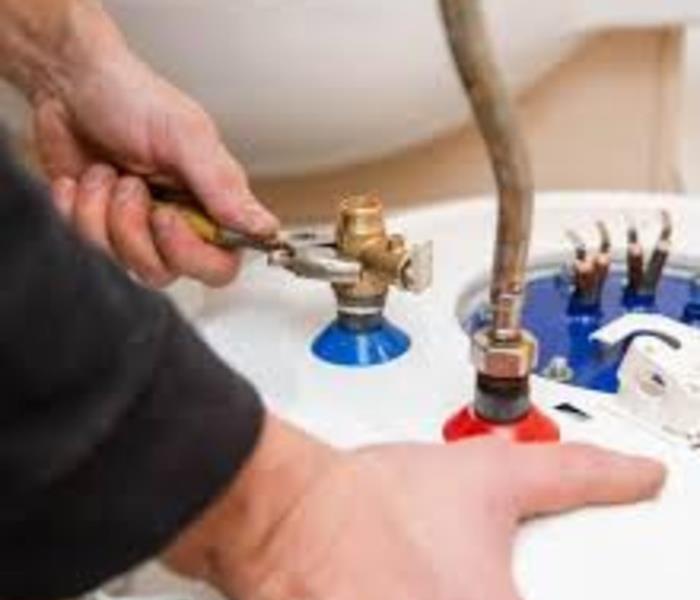 Knowing how to prevent water heater leaks or what to do when a leak occurs can save you money.
Knowing how to prevent water heater leaks or what to do when a leak occurs can save you money.
Homeowners understand that appliances don’t last forever. However, many don’t realize that even a good quality water heater will only last about 10 years before needing to be replaced. The constant filling and refilling of the tank leads to corrosion, which can lead to the tank bursting at its seams. Although using a water softener and scheduling regular maintenance can help extend the life of your unit, it will still need to be replaced once it gets over 12 years old. If you’re not sure the age of your water heater, look at the manufacturer’s serial number. The first two digits in the code represent the last two digits of the year your water heater was produced. For example, if you see “04” then your water heater was manufactured in 2004.
Act Quickly
Once you discover your water heater is leaking, the faster you act, the less damage will be done. If your water heater is safely accessible, take the following steps.
Turn off the water.
The best way to avoid any additional water damage is to close off the water supply line to the tank. First, find the pipe leading from the main water line into the top of the hot water heater tank. The water shut off valve will either be a knob or level. Once you locate the valve near where the water supply line meets the tank, twist it clockwise to stop water from entering the tank. If the water shut off is a level, pull it so it is perpendicular to the water line.
Turn off the power.
On most standard water heaters, there’s an electric or gas heating element designed to be submerged under the water. If the water is turned off and the tank is dry, this element can become a fire hazard. To prevent this, find the breaker for the water heater and turn it off.
Call an Emergency Plumber
After you’ve made sure no more water is leaking, call a plumber with 24/7 emergency services. A plumbing professional will examine your water heater and determine what caused the leak and the best way to deal with it. If your water heater is fairly new or the damage isn’t severe, a plumber will have the tools and skills to repair it. If repair isn’t an option, they’ll help you determine the best replacement option. They might even suggest you switch to a tankless water heater.
Call SERVPRO of Kendall County
Water heaters can have up to 40 to 120 gallons of water in them—more than enough water to cause some serious water damage. Water heaters located in a closet or attic usually have the potential for the greatest amount of damage, but even those located in garages or basements can be a problem when they start to leak. Not only can the water saturate your carpets and soak into your drywall, it can get behind your walls or in crawl spaces and lead to the growth of mildew and mold.
At SERVPRO of Kendall County, we can help you devise a plan to clean and restore any and all water damage to your home or belongings from a leaky water heater. We handle mold removal, odor removal, and any reconstruction and restoration due to saturated drywall. Our service professionals are certified by the Institute of Inspection, Cleaning and Restoration Certification (IICRC), which is the hallmark of professional knowledge in the cleaning and restoration industry. We use state-of-the-art equipment and employ structural drying techniques to dry your structure as quickly and completely as possible.
Recovering after a Tornado
9/13/2022 (Permalink)
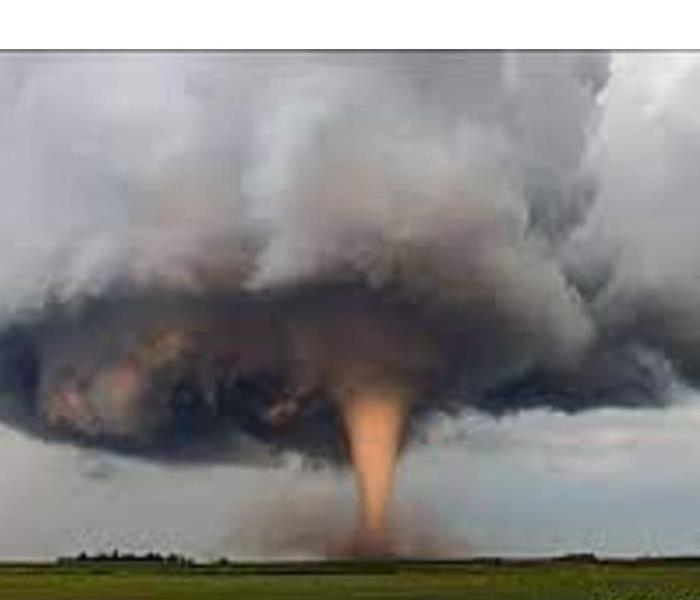 Recovering from any disaster is a gradual process, but the better prepared you are, the easier and faster your recovery can be.
Recovering from any disaster is a gradual process, but the better prepared you are, the easier and faster your recovery can be.
Your post tornado disaster plan should cover many facets…
- Health and safety
- Quickly check for injuries to assess needed attention.
- Do not move the seriously injured unless they’re at risk of immediate danger. Call for help.
- Refer to local news or your weather radio for updated information and instructions, such as shelter, clothing, food and water from FEMA, Red Cross and other volunteer agencies.
- Only return when authorities tell you it’s safe.
- Ensure drinking water is safe. Do not drink, brush teeth, or wash hands or dishes with water until it has been declared safe.
- BOIL: Boil for one minute, then cool, storing in clean, covered containers.
- BLEACH: 1/8 teaspoon or 8 drops of regular, unscented, liquid household bleach per gallon should be used. Let water stand 30 minutes before using.
- Manage food supplies. Throw out any foods that have come in contact with floodwater, including cans and water bottles that appear sealed.
- Do not flush toilets until you know sewer lines are intact and properly functioning.
- Opt for battery powered lighting over candles.
- Keep pets under control.
- Communication
- Use the telephone only for emergency calls.
- Keep a battery-powered radio on hand at all times.
- Travel
- Stay off the streets.
- Only travel when roads have been cleared safe by authorities, or when absolutely necessary.
- Beware of washed out roads, unsafe structures (building, bridges, etc.), downed power lines, chemicals spills, animals, and other health and safety risks.
- Rebuilding
- Never enter a damaged building. When in doubt, consult a qualified building inspector prior to entrance.
- Don’t return to a flood damaged area until it has been cleared as safe by authorities.
- Wear long pants, a long sleeve shirt, and sturdy shoes when surveying for damage.
- If it is safe, turn off all utilities at the source (water, gas, electricity).
- Unplug appliances and let them dry out.
- Watch for damaged power and gas lines – report them to the utility company immediately.
- If you smell gas, immediately vacate the premises and notify the fire department and gas company.
- Quickly address spilled medications, chemicals, and flammable liquids that could pose fire and safety hazards.
- Take photos of damaged structures and contents for insurance claims.
- Set priorities, and do not exhaust yourself.
- When clearing a flooded basement, do so slowly, draining about 1/3 per day, to prevent building collapse.
- When rebuilding, consider adding a tornado safe room. Funding grants may available in your area.
- Keep a good record of cleaning and repair costs for insurance reimbursement.
- Professional help
- SERVPRO of Kendall County is available 24/7
- Strengthen your home’s structure when rebuilding with the appropriate reinforcements such as anchors, clips, straps.
- Use sturdy building materials and the proper structural supports for masonry walls and chimneys.
- Permanently attach your manufactured home to its foundation.
- Have all utilities – electrical, gas, and water – tested for safety before restoring operation.
- Pump out wells and have well water tested for contaminants before drinking.
- Emotional needs
The emotional toll a disaster takes can be more devastating than physical damage and financial difficulties combined. Children and older adults are particularly at risk. Don’t neglect emotional needs. Get help. Contact FEMA, the Red Cross, other volunteer agencies, local churches, or your health insurance company for professional counseling assistance. - Letting everyone know you’re safe.
Register for the American Red Cross Safe and Well program by web site or phone (1-866-GET-INFO) to let family and friends know you're safe. - Familiarize yourself with the American Red Cross Tornado Safety Checklist.
Have a tornado disaster plan in place for before, during, and after a tornado. Luck favors the prepared!
 Whether it's due to spills, leaks, humidity, or lack of ventilation, it’s important to get that mildew smell out of the carpet as soon as possible.
Whether it's due to spills, leaks, humidity, or lack of ventilation, it’s important to get that mildew smell out of the carpet as soon as possible.





 24/7 Emergency Service
24/7 Emergency Service








